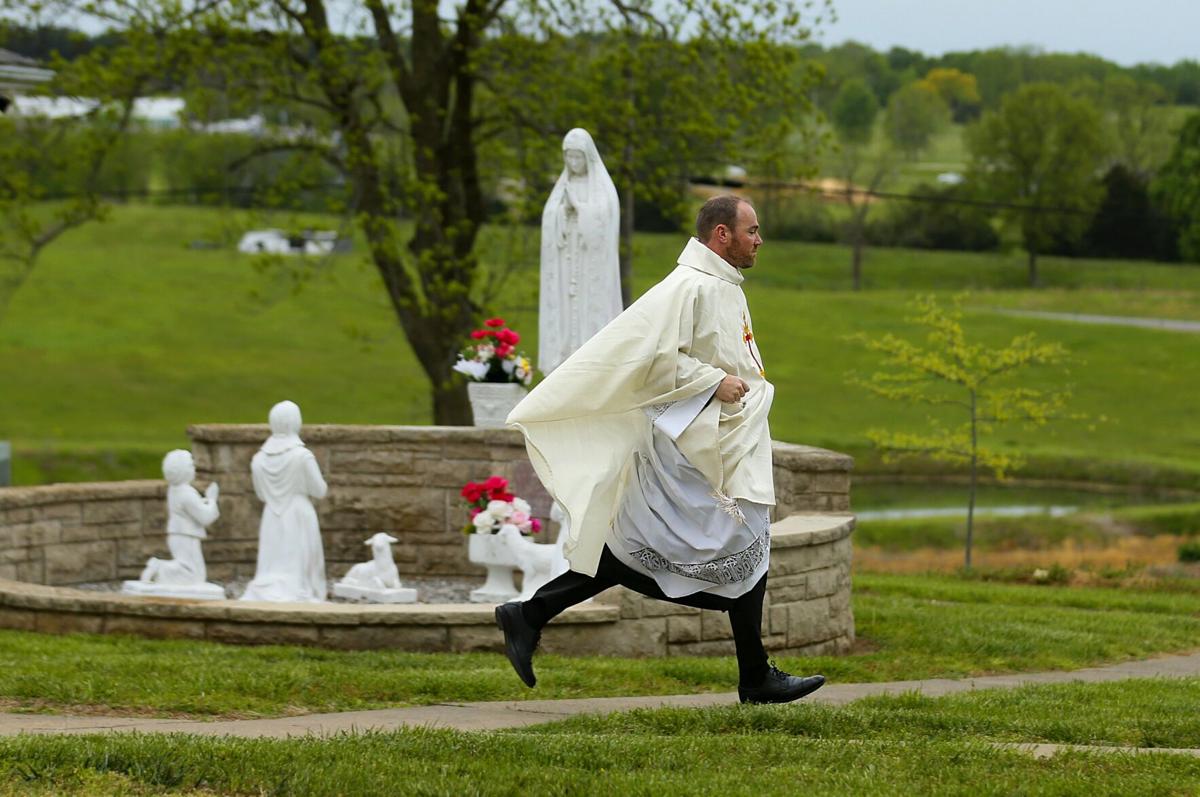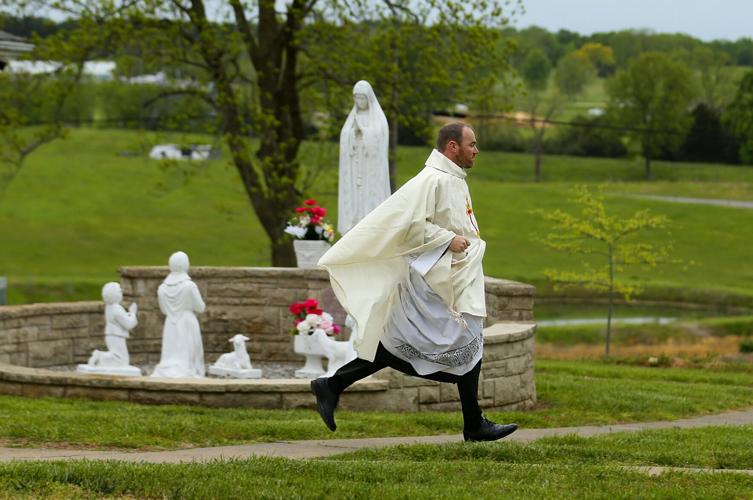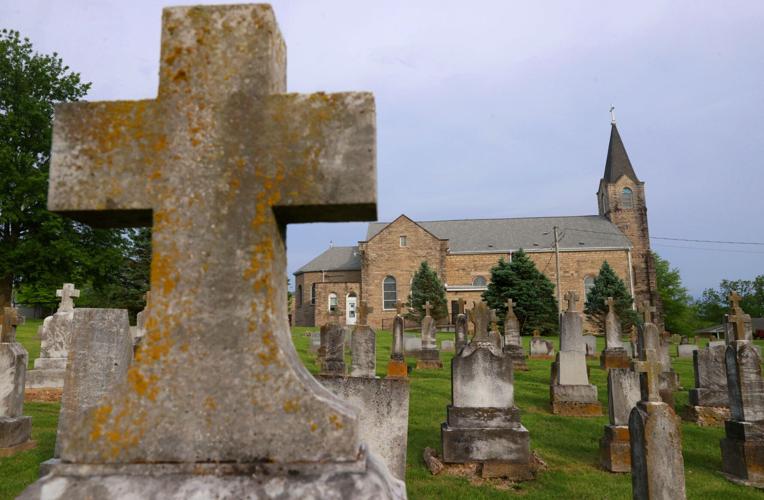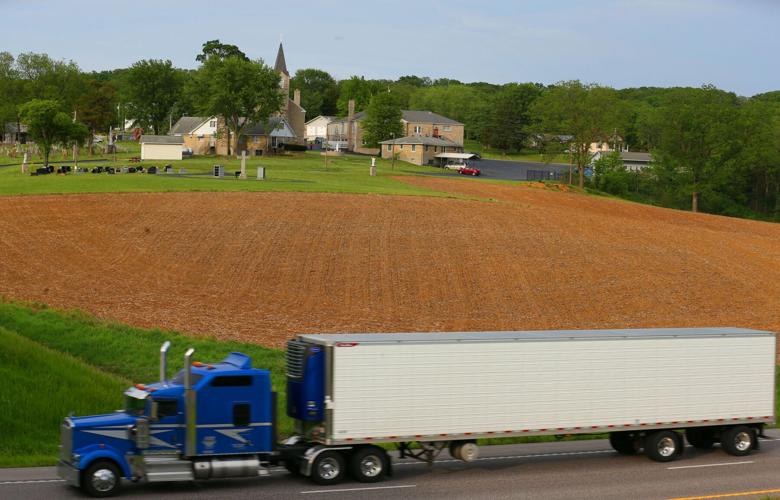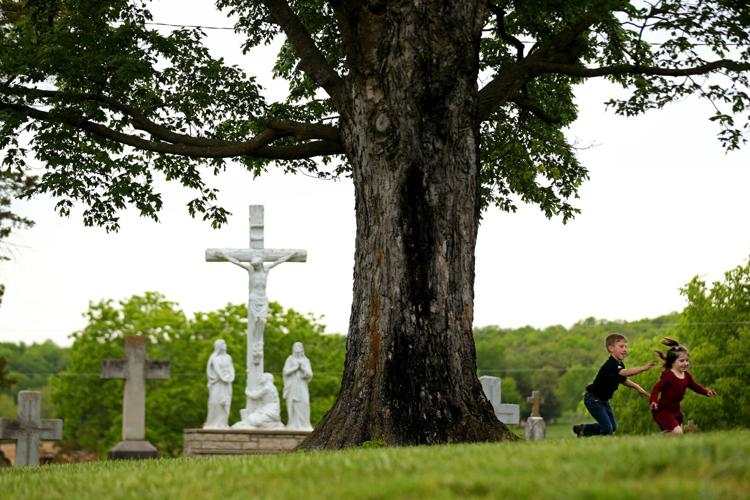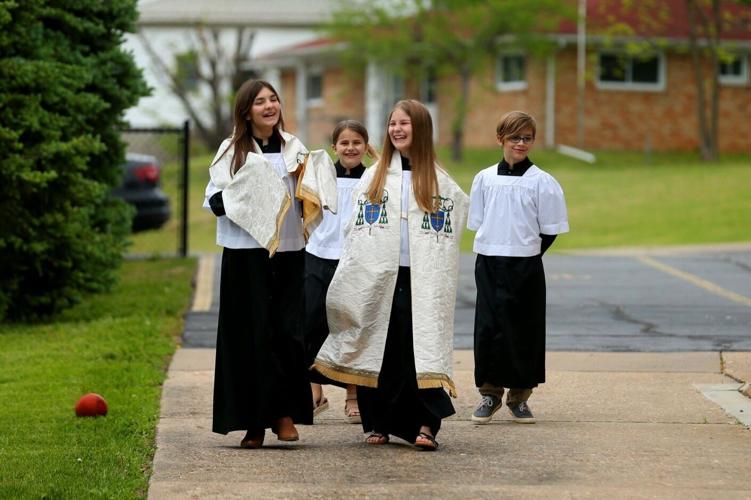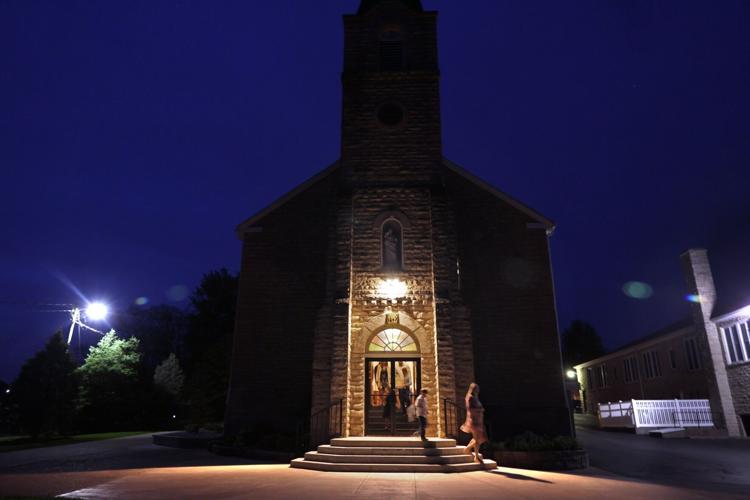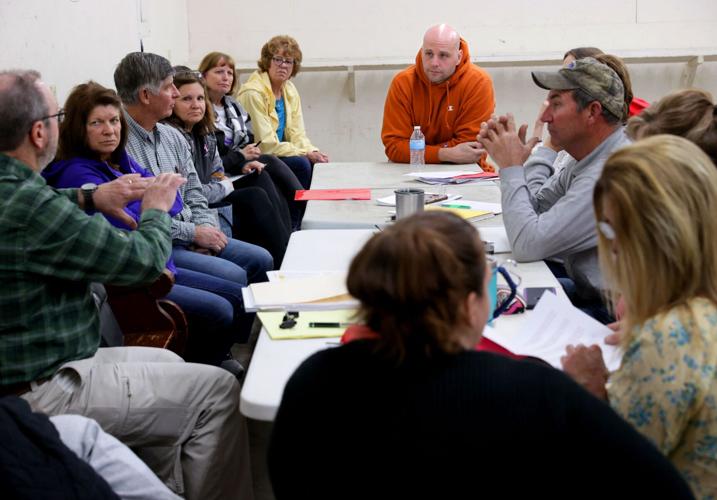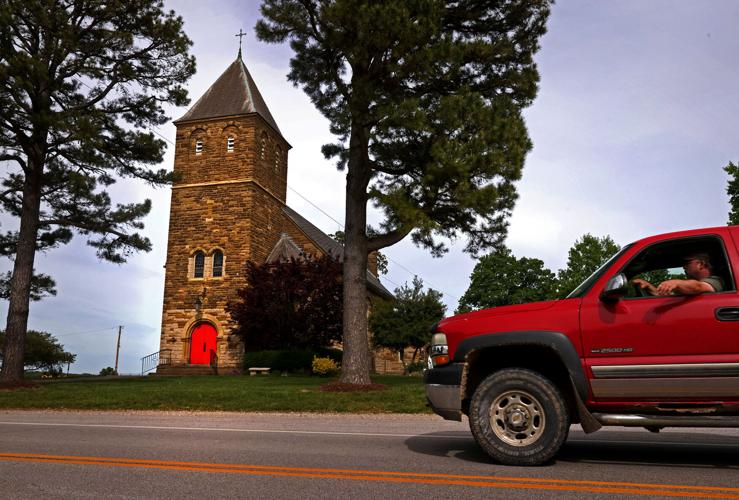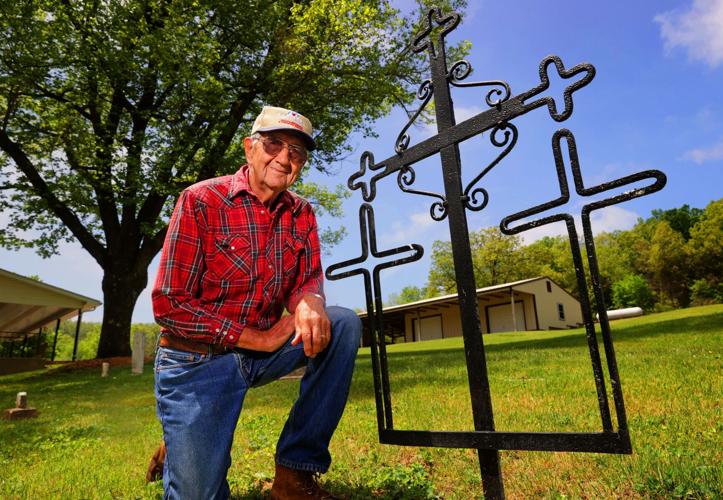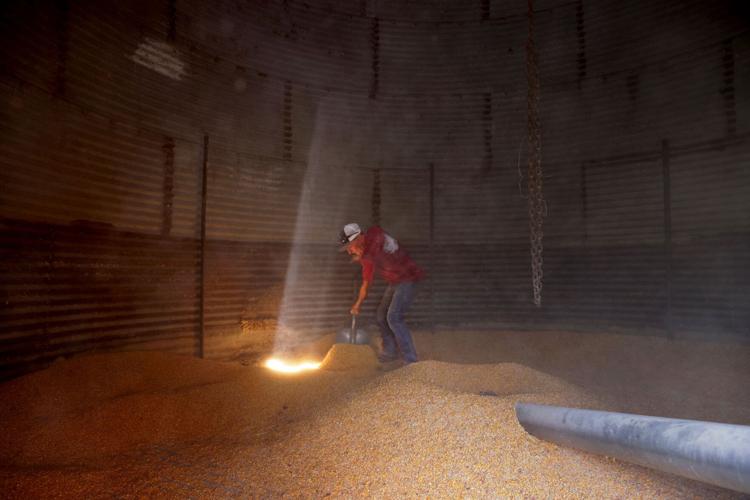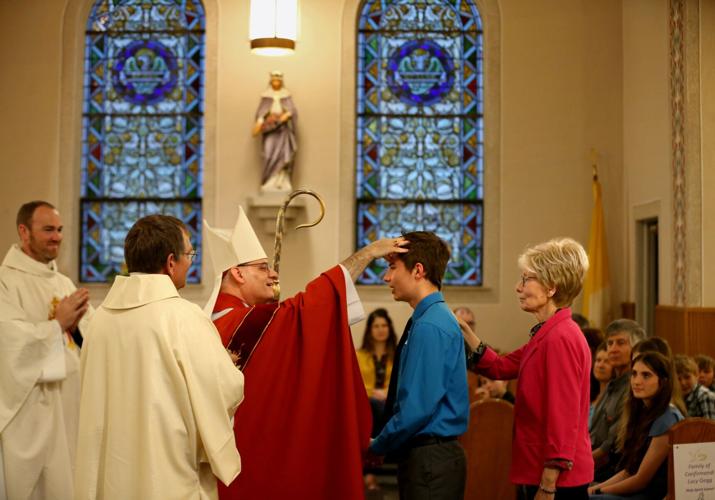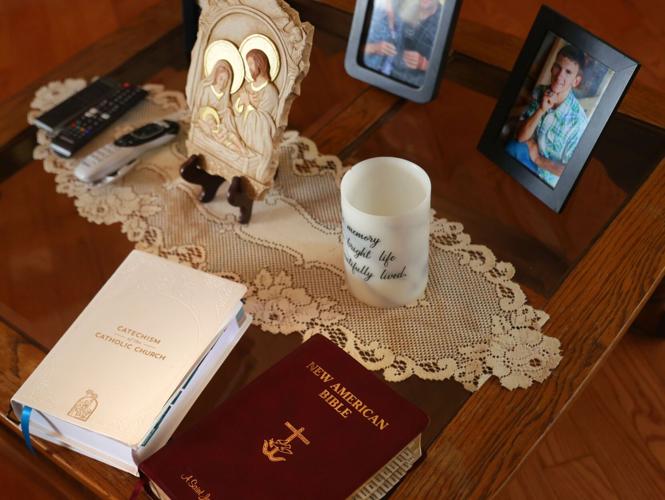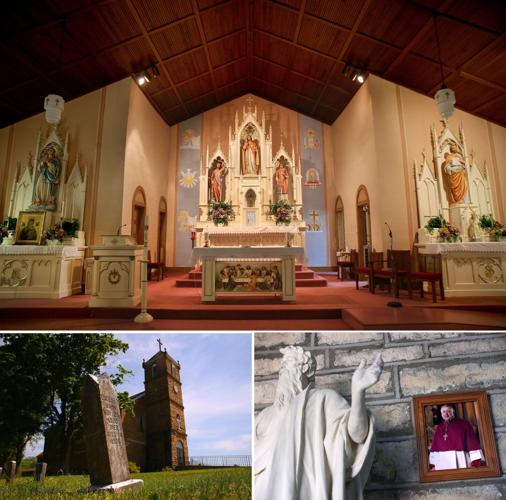ZELL, Mo. — St. Joseph Catholic Church is the focal point of this small town in rural Ste. Genevieve County, which still resembles the village German immigrants left nearly two centuries ago. Built by ancestors of some of the current members, it has long been an anchor and meeting place in unincorporated Zell.
And yet on a recent night, with its future in question, parishioners did not gather on the hallowed ground of the white stone campus.
They said they weren’t allowed to.
Instead, lay leaders, as well as representatives from a handful of other rural parishes in the area, met right across the parking lot from St. Joseph, at the volunteer fire department. It smelled of exhaust fumes lingering from a big truck that pulled out to accommodate them.
“We need to come up with viable alternatives,” said Matt Blumenfeld, 38, one of 17 people seated at a long table inside.
People are also reading…
Without any priests present, they’d come to strategize responses to St. Louis Archbishop Mitchell T. Rozanski’s final “All Things New” restructuring plan, which, after a year and a half of speculation and headlines, will be formally unveiled next weekend. Rozanski has said prudent decisions need to be made to better evangelize in an era of fallen church attendance and fewer priests.

Matt Blumenfeld, center, Joe Young, left, and other lay Catholic leaders from rural Ste. Genevieve County parishes meet April 27, 2023, at the Zell volunteer fire department to discuss ways to guard their churches from being shut down by St. Louis Archbishop Mitchell T. Rozanski's plan to consolidate the archdiocese. Mickey Flieg is seated on the lower right.
The Archdiocese of St. Louis has said that it wants about 1,800 households grouped together some way, which, considering existing church attendance, would require a lot of square miles in rural areas. Some small parishes feel like they have a bull’s-eye on their backs, even though their finances, buildings and attendance are solid.
They believe they have something special that needs to be protected, not “suppressed.”
But they think their voices aren’t being heard by the archdiocese.
And so members of St. Joseph, which draws about 225 people to weekend services, went out and gathered more than 170 signatures to designate Blumenfeld as their “procurator.” That way, he said at the meeting, he can speak officially and quickly on behalf of congregants, should an appeal be needed to stave off closure or a decision from the archdiocese that would effectively close the parish, such as removing their resident pastor and cutting off access to other clergy.
Blumenfeld said he’d been in contact with a canon lawyer and sent an official letter to Rozanski, calling for more time to refocus and reengage Roman Catholics who haven’t come back to church since COVID-19 and news of the clergy sex abuse crisis breaking open in 2002.
As he awaited answers from the archdiocese, Blumenfeld said he’d been considering the realities of relying on a lay parish life coordinator or deacon to run things day-to-day. He’d entertained the idea of finding a priest on his own who could be vetted by the archdiocese. Perhaps a friend of another priest he knows in Virginia, originally from Uganda, could come over and help.
It would be a role reversal for St. Joseph, which produced nine priests and 21 nuns.
“Why don’t they consider changing the model for the priests, instead of changing the model for all the parishes?” Blumenfeld said. “We need missionaries in this country. We used to send a lot of people overseas. Now we are the ones in need.”
Photos: St. Joseph Catholic Church in Zell, Missouri
St. Joseph Catholic Church in Zell, Missouri is one of the oldest parishes in the Archdiocese of St. Louis dating back to 1847. The congregation there is one of several historic Ste. Genevieve County parishes now contemplating its fate as the All Things New reconfiguration plan is implemented. Photos by Christian Gooden, St. Louis Post-Dispatch
The archdiocese, which oversees the Catholic experience in St. Louis and 10 surrounding Missouri counties, said early on in the “All Things New” process that being unable to produce its own priests was a sign of weakness. Considering future projections, one of its first publicized restructuring models had Ste. Genevieve Parish, in the town of Ste. Genevieve, absorbing all seven rural parishes in the county. That plan was poorly received, which some believe helped change the narrative.
Rural parish in Roman Catholic Archdiocese of St. Louis hopes to keep their historic church open. Video by Jesse Bogan and Gary Hairlson
“Parish” is no longer the main metric. Now it’s “pastorate,” a more squishy term, some at the meeting believed.
Currently, the archdiocese says some individual parishes may be their own pastorate, perhaps with some adaptations to church services “due to priest availability,” which seems most likely for large, suburban parishes. In another scenario, the archdiocese says two or more parishes would remain financially independent but become a new pastorate under one pastor or pastoral team, which seems likely for some rural and urban churches.
“Only after we have discerned which communities ought to come together as a new pastorate can we begin the case-by-case examination of which structure is most prudent for each existing parish,” the archdiocese says. “No matter the chosen structure, some worship sites may no longer be used in the future.”
Reporting signals those decisions will be hard to accept in Ste. Genevieve County, one of the most Catholic areas of the archdiocese.
Under the latest restructuring model, Our Lady, Help of Christians in Weingarten, Sts. James and Philip in River aux Vases and Sacred Heart in Ozora would still be with Ste. Genevieve Parish, which seats 960. Others — St. Joseph in Zell, St. Agnes in Bloomsdale and St. Lawrence in Lawrenceton — would be grouped together.
“Nothing against Bloomsdale. I’d rather stay here in Zell. Our roots are here,” said Paul Flieg, 59, a farmer whose family name dates to at least 1869 in town records.

Paul Flieg shovels corn inside a grain bin on Wednesday, May 10, 2023, as he prepares to grind chicken feed at his Ste. Genevieve County farm. Flieg and his wife, Mickey, are regulars at St. Joseph Catholic Church in Zell, Missouri.

A photo of Mickey and Paul Flieg's son Dennis (top right), who was killed in a tractor accident in 2013, is displayed alongside a Bible and Catechism of the Catholic Church at their Ste. Genevieve County home on Wednesday, May 10, 2023.
“It’s a sacred building on sacred ground,” added his wife, Mickey, 50.
Their 17-year-old son, Dennis, who was killed in a tractor accident in 2013, is buried in the church cemetery, which also motivates them to fight for St. Joseph.
Joe Young, 66, of St. Agnes, said he had two canon lawyers on retainer and had spoken to several others. He shared a variety of documents with the group, including one that says a lack of priests isn’t “just cause” to close a parish. Even though the archdiocese has one of the best ratios of priests per number of Catholics in the country, he encouraged everyone present to continue to work on their action plans to stay intact.
“Time is getting short,” he said.
Changing history
And yet time goes back the farthest here.
Ste. Genevieve, the oldest permanent European settlement in Missouri, was founded around 1740 by French-Canadians, including some who migrated from Illinois Country, just across the Mississippi River. Traders and explorers were drawn to the area by salt springs and lead.
They brought Catholicism with them. So did many of the German immigrants, who later came up the Mississippi River, primarily from New Orleans. Some were drawn to the town of Ste. Genevieve; most settled in surrounding farming communities like Zell.
Barbara McClurkin, author of “Seventy-Five years of German Immigration to Ste. Genevieve County, Missouri: 1800-1875,” said in a telephone interview that many traveled in large groups from the same regions in Germany, like Baden, which borders France along the Rhine River.
“Most of them came hoping to establish a new Germany,” she said. “They brought their culture very much with them.”
They built and supported churches that remain today.
“The demographics and the dynamics have not changed in Ste. Genevieve County, for all intents and purposes,” McClurkin said. “The social and family contacts are still there. And they are still very much connected to those churches.”

Roman Catholic churches including St. Lawrence in Lawrenceton, Mo., (top), Our Lady, Help of Christians in Weingarten, Mo. (lower left) and Sts. Philip and James in River aux Vases, Mo., are among the rural Ste. Genevieve County parishes in the Archdiocese of St. Louis being looked at for consolidation.
Throughout history, there have been various strategies to serve Catholics in remote Ste. Genevieve County that often included priests riding a circuit. The Rev. John Rothensteiner wrote in his 1928 history of the St. Louis Archdiocese, a two-volume set, that there were more than half a dozen towns in the area whose churches “branched off from the old mother parish” in Ste. Genevieve.
For instance, parishes in Bloomsdale, Lawrenceton and French Village, just across the border in St. Francois County, formed a “ragged outline of an isosceles triangle,” he wrote. At various times, the three churches were administered as one “parochial entity” that was “united under the pastorship” of one priest. In 1882, the priest lived in Bloomsdale, but “visited his two missions of Lawrenceton and French Village in rotation every Sunday morning for the purpose of saying mass and performing the other functions of his pastoral office.”
“After a year of such strenuous missionary labor,” Rothensteiner noted, the priest was transferred to Ste. Genevieve. His replacement lasted about four years in the same arrangement. Then Lawrenceton had a series of eight resident priests who also served the spiritual needs of St. Anne Catholic Church, 5 miles down the road in French Village.
During that era, Rothensteiner reported, Lawrenceton had 40 families, about the same as it has today — though families are much smaller. They lost their resident pastor in 1967. The priest at St. Agnes in Bloomsdale has kept them going since. Once a week, he drives 7 miles to Lawrenceton to celebrate Mass at St. Lawrence early Sunday morning, then rushes back.
Does the pope know?
Pershing Carron would like the same arrangement to continue in Lawrenceton, which, by his count, has 11 people in town, with dozens more off in the hills.
The Navy veteran is spry for 90. He sings in the choir. He rings the bell tower and watches over the grounds. He grew up there. He moved back with his wife in the 1990s, after raising a family in St. Charles and retiring from McDonnell Douglas as a machinist.
“It always had a tender spot in my heart,” he said.
His great-grandfather helped establish the original church, dedicated in 1872. Forty-five years later, the community persevered to rebuild after a tornado destroyed the church in 1917.
Now, Carron doesn’t think St. Lawrence can overcome what he described as a global church’s failure to modernize.

Pershing Carron, 90, poses at the grave marker of his great-grandfather, Hearsta Richard Veith, on Tuesday, May 9, 2023, at St. Lawrence Catholic Church cemetery in Lawrenceton, Mo. Veith died in 1872, the same year the church he helped establish was dedicated in rural Ste. Genevieve County.
“I hate to go into all this, but part of it originates in Rome,” he said. “The first thing: Is the pope so oblivious that all of this is going on?”
He said the lack of priests reflects a lack of awareness at the Vatican.
“The pope says we can’t have women for pastors. We can’t have married people for pastors. And who knows more about family life than a husband and wife?” he said. “When are we going to take our blinders off and see what the real world is about?”
As is, he said, St. Lawrence only has a couple families with children these days and hasn’t had a baptism in a while. But it’s a devoted flock. Financially, the congregation is in decent shape. They still pay tuition for their youths to attend Catholic schools in Bloomsdale.
And Carron said the brick church doesn’t have any major flaws. Nor do the outbuildings, used to host a famous annual fried chicken feast — though not last year. On recent days, the grass was freshly cut, with mulch spread nice and tidy around the base of trees. The cemetery also looked well taken care of.
“I truly feel, and I’d hate to see this, that this church will be shut down,” said Carron, out in the graveyard, where his ancestors are buried. “Our problem is, if it closes, what do you do with a building like this?”
‘Continued presence’
Bob Palmer isn’t Catholic, but as president of Bloomsdale Bank, which dates to 1914, he and the board of directors have faced similar obstacles regarding branch offices.
Consolidation may be cheaper, he said, but not better.
“It’s that sense of community in a Zell, a Bloomsdale, and Ozora that people want to be a part of,” Palmer, 65, said from his desk. “You’ve got to be where the people are.”
And available. His office door was open. He takes random calls.
“If you want to call Bloomsdale Bank, just pick up the phone,” he said. “If you want to talk to the president of the bank, just ask for him.”
Residents around Ozora have had that kind of access for more than 20 years at Sacred Heart Catholic Church.
“Father knows everybody by name — Sister, too,” said Tom Otte, 63, who lives on a century farm where he grew up. “They get along with everybody. It’s unreal.”
The Rev. Jim Schaefer, 93, and Sister Agnes Marie Keena, 80, came to Sacred Heart from St. Norbert Catholic Church in Florissant more than 20 years ago. They are both active.
“I love what I am doing, and I feel like I am making a difference — and I still have the energy,” said Sister Agnes.
She had previous stints in Dubuque, Iowa; Wichita, Kansas; Chicago; Kansas City; and St. Louis, where she was raised. She described the Sacred Heart congregation as “alive in Christ.”
“People know each other. They talk to each other. They don’t just leave and go on their merry way. They are interested in what people are doing,” she said. “I never thought I’d like rural. I love this. The people. You really are part of their families.”

A motorist passes Sacred Heart Catholic Church in Ozora, Mo. on Thursday, May 4, 2023, on State Route N in Ste. Genevieve County.
She said she has written Rozanski about her concerns for the parishioners.
“I was positive, but I don’t feel they are being listened to,” she said. “I wish he wouldn’t have gone down this road. I wish he’d gone a little slower.”
Sister Agnes served as a school principal in the archdiocese for 47 years. When enrollment fell to 15 students at Sacred Heart elementary, it closed in 2014.
“The people decided,” she said. “That makes a difference. It was hard, but people understood. (Now), it’s almost like they are imposing closure.”
If the church is going to die, she prefers a natural death.
“People are more prepared,” she said.
But she said Sacred Heart still has a lot of life left in the 140 families that go there.
“Most of them grew up here,” she said. “Their young kids are staying here, to farm, to take care of the land. We don’t have many that move away.”
Toni Grass, one of her former students, was an exception. She left to join a Roman Catholic religious order. In her early 30s, she’s serving in Canada as Sister Rose Catherine.
Otte’s son, Tommy, also got away. He’s an auditor in St. Louis. This fall, he hopes to enter Kenrick-Glennon Seminary in Shrewsbury to pursue becoming a priest in the St. Louis Archdiocese.
In a telephone interview, Tommy Otte, 23, recalled hearing Sacred Heart’s bell tower from the pasture lands of his family farm. Because it’s a small parish, he said, everyone is counted on to participate in different ways. For him, that included being an altar server, singing in the youth choir and playing trumpet for Christmas Eve Mass every year.
He said church involvement, and being one of five students in his elementary school class, had a lot of impact on his spiritual life and eventual pursuit of the priesthood.
“Especially Father Jim and Sister Agnes being around since I was born until now,” he said. “Their continued presence.”
Growing rift
St. Joseph in Zell has served as an unofficial hub of the rural parishes in Ste. Genevieve County since a cornerstone was laid in 1845.
It’s one of the longest continually running churches in the archdiocese.

St. Louis Auxiliary Bishop Mark Rivituso, center, administers the Confirmation of eighth-grader Josef Rottler on Thursday, May 4, 2023, as the boy's grandmother and sponsor, Sharen Gettinger, presents him at St. Joseph Catholic Church in Zell, Mo. The Rev. Henry Purcell, pastor, left, and Deacon Allen Engelmann serve as officiates at the ceremony that performed 11 Confirmations of youth from several Ste. Genevieve County parishes.
While lay leaders from various congregations spoke calmly at their recent meeting at the firehouse in Zell, some parishioners were more raw.
“There’s blood, sweat and tears in this area that no one will understand,” Sharon Werner, 67, said of generational investment into the church and school.
Werner said she grew up in Zell, one of eight siblings. When her parents didn’t want them to understand, they spoke in German. Her grandparents were neighbors. Three of her uncles from Zell became priests.
“It’s home,” she said.
But she may find a different denomination. The threat of consolidation angers her too much.
“If I wanted a mega church, I could find one,” she said. “It’s real easy.”
Her husband, Dennis, 68, agreed. He used to be an altar server at St. Lawrence when he was a boy. He said the lay deacon should be leaned on more to keep St. Joseph open.
“That archbishop could send some hosts down here,” he said of sacramental bread used for Holy Communion.
Angst over the situation has already significantly cut into their weekly offerings.
Rather than make financial donations to the archdiocese, which might be working to shut St. Joseph down, Mickey Flieg said a few parishioners are making direct payments to cover church utilities and other bills.

With images of Jesus stacked nearby, Mickey Flieg, left, welcomes Cheryl Bauman, a customer seeking flowers and herbs at her Ste. Genevieve County farm's greenhouse, on Wednesday, May 10, 2023. Flieg and her husband, Paul, are regulars at St. Joseph Catholic Church in Zell, Mo.
“It’s still tithing, but it’s not going to the archdiocese,” she said.
Cheryl Bauman, 56, a retired elementary school principal who also served on a Catholic school board in the area, said it’s the people who have built and supported St. Joseph for generations.
“They just need to leave us alone,” she said. “If the archbishop is truly listening to the parishioners, and he truly has their best interest at heart, things will stay the same.”
Bauman said she has personally tried to reach Rozanski by telephone to express her concerns but hasn’t gotten through. She said if he could prove that consolidating would save more souls, she’d be on board. She fears the opposite.
“He’s setting us up for hell if he goes through with this,” she said. “People are going to fall through the cracks.”
Originally posted at noon Thursday, May 18.
Deacon Tom Mulvihill, co-director of the St. Louis Archdiocese's reclamation center in Shrewsbury, talks about what happens to items that need new homes within the Catholic church. Video by Valerie Schremp Hahn







